If you are a football fan you have heard the timeless quote "the best defense is a good offense". That statement is solidly true in pocket billiards. Many situations arise in all the different disciplines of pool, but the "offensive safety" or "two way shot" is very prevalent in rotation games such as 9-ball or 10-ball.
When should I play a two way shot, you might ask. Well, in this article we will cover a few examples of basic two way shots in rotation games and of course in my favorite game 14.1.
Diagram 1: 9-Ball Scenario
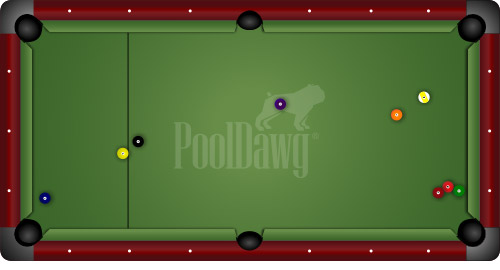
In the first set of diagrams you are playing a game of 9-ball and your opponent has scratched on the break and given you ball in hand. Notice how the balls are clustered up on the end rail. Now you could easily pocket the 1 ball and play position for the 2, but the 3 ball is going to need to be broken out if you are going to continue your run. The smart two way shot is illustrated in diagram 2.
Diagram 2: Two Way Shot for 9-Ball
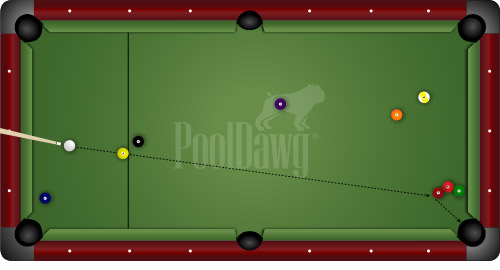
Play a harder shot on the one by shooting it down table off of the 7 ball, thereby breaking the 3 ball loose from its current locked up position. The key to the shot is to make sure you stop the cue ball behind the 8, this way should you fail to pocket the 1 ball you have left your opponent in a safe position. If you notice by doing this you have also played good position on the 2 ball.
Diagram 3: 10 Ball Scenario
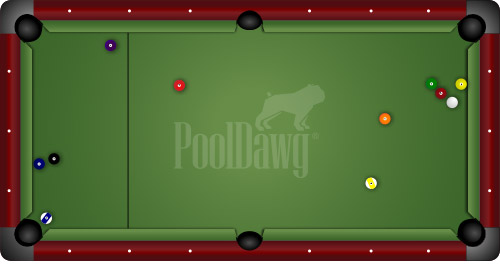
In our next scenario you can see we are playing a game of 10 ball and this is the layout you are left with after your opponent failed to pocket a ball on the break. In this position you have a few options, you could play the 1 ball but getting position on the 2 ball is very difficult. So I propose you use the magic of the two way shot.
Diagram 4: Two Way Shot for 10-Ball
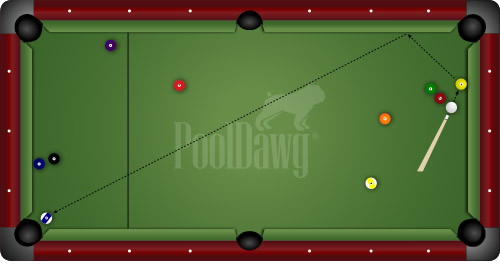
The simple solution in diagram 4 would have you hit the 1 ball full in the face and follow the cue ball behind the 6 and 7 balls. You have now played a great safety, but where is the two shot here? Well by hitting the 1 ball full with the right speed you can drive it two cushions towards the hanging 10 ball. If you make it you have won the game. If you miss it, your opponent is left snookered and you have strategically placed the 1 ball down by the 2 and 3.
 Frank Says: "Like a good two way shot the Tip Pik Shadow Chalker also offers a win-win scenario. It holds your chalk to keep it close at hand and has a tip pik to perforate the tip for better chalk retention!"
Frank Says: "Like a good two way shot the Tip Pik Shadow Chalker also offers a win-win scenario. It holds your chalk to keep it close at hand and has a tip pik to perforate the tip for better chalk retention!"
Diagram 5: Straight Pool Scenario
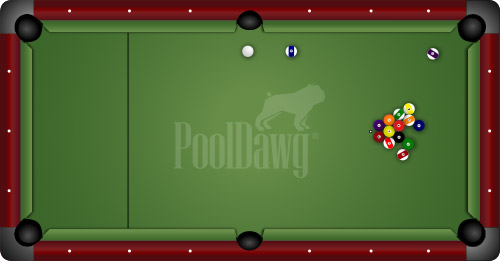
Finally in our last diagrams we are playing a game of 14.1. The layout of the balls shows very few good options for hitting the rack to break them up. Why not play a two way shot?
Diagram 6: Two Way Shot for Straight Pool
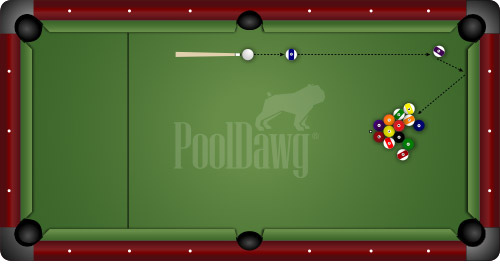
The execution of the shot in diagram 6 is relatively simple with some practice, and comes up quite often. What you want to do is play the combination, but make sure you stop the cue ball in position and hit the shot hard enough that the 10 ball caroms off the 12 after pocketing it in the corner and slams into the rack. This is a risk free shot that controls the cue ball and generally yields several more shots to choose from after breaking up the stack.
Just remember folks, look for the obvious, don’t over think it, and execute with confidence.
Until next time,
Mikey V.
- RELATED ARTICLES
- Some Clever Safety Ideas - by Mark Finkelstein
- Your Guide To More Smarter 8 Ball - by Liz Ford
- Two Way Shots - by Jennifer Barretta